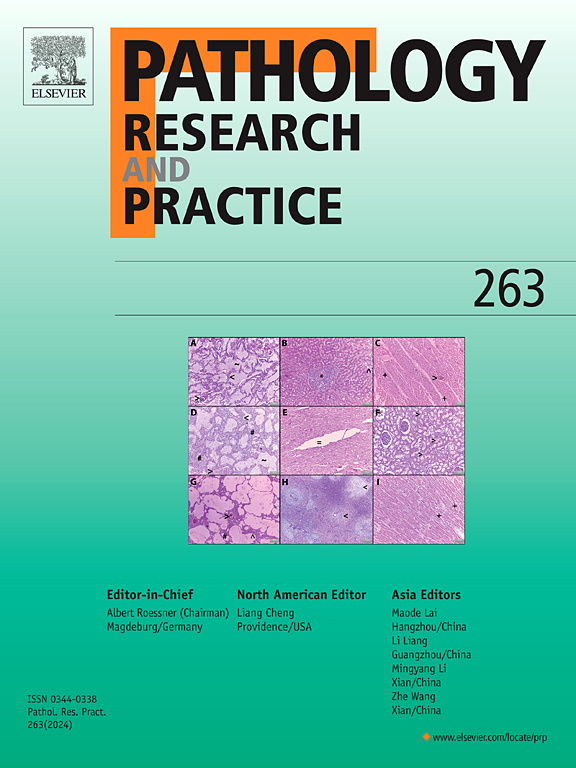Pancreatic panniculitis associated with presumed advanced pancreatic tumor: A case report and literature review
IF 3.2
4区 医学
Q2 PATHOLOGY
引用次数: 0
Abstract
Pancreatic tumor-associated panniculitis is a rare paraneoplastic syndrome, primarily caused by systemic release of pancreatic enzymes (e.g., lipase) from malignancies like acinar cell carcinoma (ACC), leading to necrotizing inflammation in subcutaneous and other adipose tissues. This report details an 87-year-old female presenting with progressive skin lesions (erythematous rash → indurated swelling → ulceration with purulent drainage), lower limb pain, fever, and markedly elevated lipase (3686.2 U/L). Skin biopsy confirmed lobular panniculitis with characteristic "ghost cells". Imaging revealed a pancreatic tail mass and liver lesions. Despite sequential anti-infectives, glucocorticoids, Octreotide, Somatostatin, Ulinastatin, and Cimetidine, her condition deteriorated, culminating in death. Literature review confirms that ACC is the predominant pancreatic tumor type causing panniculitis (accounting for 85 %). Diagnosis hinges on recognizing "ghost cells" pathologically and significant hyperlipasemia (often >4000 U/L). Crucially, skin manifestations frequently precede abdominal symptoms, leading to misdiagnosis and delayed cancer management. Controlling panniculitis fundamentally requires treating the primary tumor: surgical resection (including metastases) significantly improves survival; platinum-based chemotherapy (e.g., FOLFOX/FOLFIRINOX) is preferred for ACC; and molecular profiling (BRCA/RAF/NTRK) guided targeted therapy is promising. Prognosis is poor; early recognition via clinician vigilance for unexplained panniculitis and pathologist identification of "ghost cells", coupled with multidisciplinary collaboration and aggressive tumor-directed therapy, is essential for improving outcomes.
胰膜炎合并晚期胰腺肿瘤:1例报告及文献复习
胰腺肿瘤相关性胰腺炎是一种罕见的副肿瘤综合征,主要是由恶性肿瘤(如腺泡细胞癌(ACC))胰腺酶(如脂肪酶)的全身释放引起的,导致皮下和其他脂肪组织的坏死性炎症。本报告详细介绍了一位87岁女性,其表现为进行性皮肤病变(红斑皮疹→硬化肿胀→溃疡伴脓性引流),下肢疼痛,发烧,脂肪酶明显升高(3686.2 U/L)。皮肤活检证实小叶性绒毛炎伴特征性“鬼细胞”。影像学显示胰腺尾部肿块及肝脏病变。尽管连续使用抗感染药物、糖皮质激素、奥曲肽、生长抑素、乌司他丁和西咪替丁,她的病情仍恶化,最终死亡。文献复习证实,ACC是引起胰膜炎的主要胰腺肿瘤类型(占85% %)。诊断取决于病理上识别“鬼细胞”和明显的高脂血症(通常为4000 U/L)。至关重要的是,皮肤表现经常先于腹部症状,导致误诊和延迟癌症治疗。从根本上控制膜炎需要治疗原发肿瘤:手术切除(包括转移)可显著提高生存率;对于ACC,首选铂类化疗(例如FOLFOX/FOLFIRINOX);和分子谱(BRCA/RAF/NTRK)引导的靶向治疗是有希望的。预后差;通过临床医生对不明原因的泛膜炎的警惕和病理学家对“鬼细胞”的识别,再加上多学科合作和积极的肿瘤定向治疗,对改善预后至关重要。
本文章由计算机程序翻译,如有差异,请以英文原文为准。
求助全文
约1分钟内获得全文
求助全文
来源期刊
CiteScore
5.00
自引率
3.60%
发文量
405
审稿时长
24 days
期刊介绍:
Pathology, Research and Practice provides accessible coverage of the most recent developments across the entire field of pathology: Reviews focus on recent progress in pathology, while Comments look at interesting current problems and at hypotheses for future developments in pathology. Original Papers present novel findings on all aspects of general, anatomic and molecular pathology. Rapid Communications inform readers on preliminary findings that may be relevant for further studies and need to be communicated quickly. Teaching Cases look at new aspects or special diagnostic problems of diseases and at case reports relevant for the pathologist''s practice.

 求助内容:
求助内容: 应助结果提醒方式:
应助结果提醒方式:


